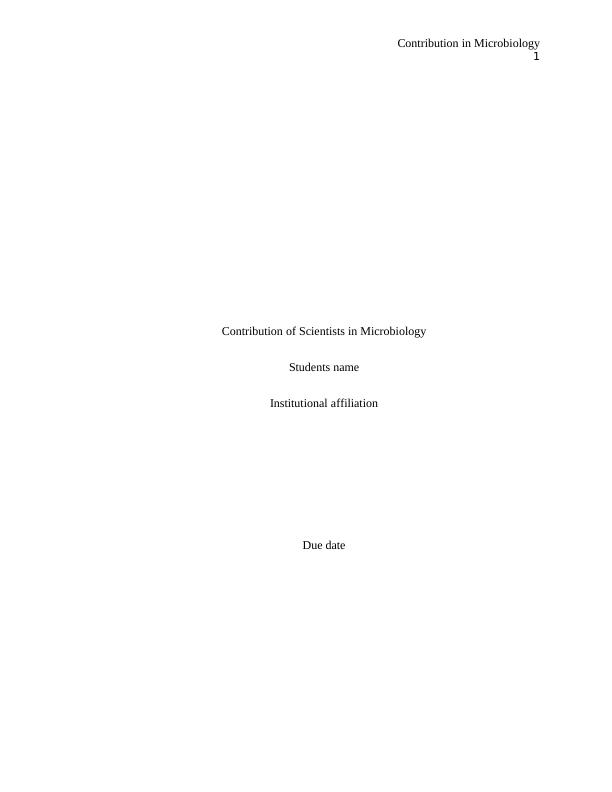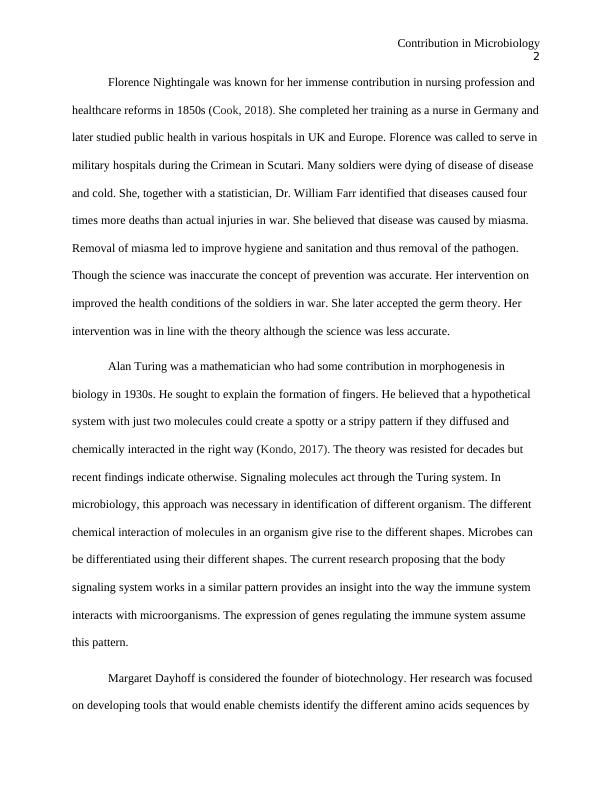Contribution of Scientists in Microbiology
Added on 2022-12-01
4 Pages751 Words392 Views
Contribution in Microbiology
1
Contribution of Scientists in Microbiology
Students name
Institutional affiliation
Due date
1
Contribution of Scientists in Microbiology
Students name
Institutional affiliation
Due date

Contribution in Microbiology
2
Florence Nightingale was known for her immense contribution in nursing profession and
healthcare reforms in 1850s (Cook, 2018). She completed her training as a nurse in Germany and
later studied public health in various hospitals in UK and Europe. Florence was called to serve in
military hospitals during the Crimean in Scutari. Many soldiers were dying of disease of disease
and cold. She, together with a statistician, Dr. William Farr identified that diseases caused four
times more deaths than actual injuries in war. She believed that disease was caused by miasma.
Removal of miasma led to improve hygiene and sanitation and thus removal of the pathogen.
Though the science was inaccurate the concept of prevention was accurate. Her intervention on
improved the health conditions of the soldiers in war. She later accepted the germ theory. Her
intervention was in line with the theory although the science was less accurate.
Alan Turing was a mathematician who had some contribution in morphogenesis in
biology in 1930s. He sought to explain the formation of fingers. He believed that a hypothetical
system with just two molecules could create a spotty or a stripy pattern if they diffused and
chemically interacted in the right way (Kondo, 2017). The theory was resisted for decades but
recent findings indicate otherwise. Signaling molecules act through the Turing system. In
microbiology, this approach was necessary in identification of different organism. The different
chemical interaction of molecules in an organism give rise to the different shapes. Microbes can
be differentiated using their different shapes. The current research proposing that the body
signaling system works in a similar pattern provides an insight into the way the immune system
interacts with microorganisms. The expression of genes regulating the immune system assume
this pattern.
Margaret Dayhoff is considered the founder of biotechnology. Her research was focused
on developing tools that would enable chemists identify the different amino acids sequences by
2
Florence Nightingale was known for her immense contribution in nursing profession and
healthcare reforms in 1850s (Cook, 2018). She completed her training as a nurse in Germany and
later studied public health in various hospitals in UK and Europe. Florence was called to serve in
military hospitals during the Crimean in Scutari. Many soldiers were dying of disease of disease
and cold. She, together with a statistician, Dr. William Farr identified that diseases caused four
times more deaths than actual injuries in war. She believed that disease was caused by miasma.
Removal of miasma led to improve hygiene and sanitation and thus removal of the pathogen.
Though the science was inaccurate the concept of prevention was accurate. Her intervention on
improved the health conditions of the soldiers in war. She later accepted the germ theory. Her
intervention was in line with the theory although the science was less accurate.
Alan Turing was a mathematician who had some contribution in morphogenesis in
biology in 1930s. He sought to explain the formation of fingers. He believed that a hypothetical
system with just two molecules could create a spotty or a stripy pattern if they diffused and
chemically interacted in the right way (Kondo, 2017). The theory was resisted for decades but
recent findings indicate otherwise. Signaling molecules act through the Turing system. In
microbiology, this approach was necessary in identification of different organism. The different
chemical interaction of molecules in an organism give rise to the different shapes. Microbes can
be differentiated using their different shapes. The current research proposing that the body
signaling system works in a similar pattern provides an insight into the way the immune system
interacts with microorganisms. The expression of genes regulating the immune system assume
this pattern.
Margaret Dayhoff is considered the founder of biotechnology. Her research was focused
on developing tools that would enable chemists identify the different amino acids sequences by

End of preview
Want to access all the pages? Upload your documents or become a member.